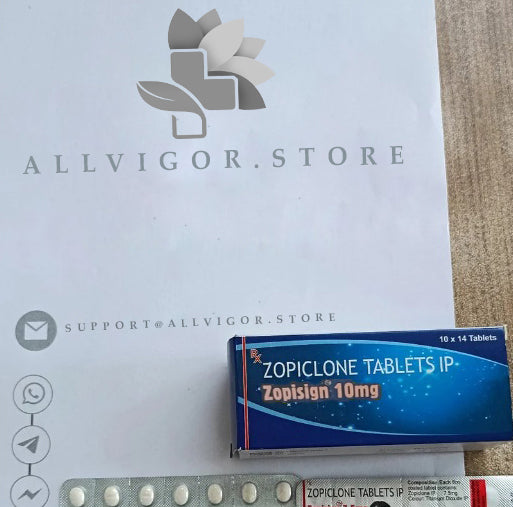What is zopiclone?
Zopiclone is a medication commonly used to treat insomnia, which is a persistent trouble with sleeping. It’s a type of sleeping pill that's part of a category known as non-benzodiazepine hypnotics. Although it’s structurally different from benzodiazepine sedatives like Halcion (triazolam), it works in a similar way and has comparable effects and side effects.
The way zopiclone helps is by making it easier to fall asleep, increasing how long you stay asleep, and reducing how often you wake up during the night. It generally takes about an hour to start working.
Zopiclone functions by attaching to a specific receptor in your brain called the GABAA receptor. This boosts the effects of GABA, a neurotransmitter that promotes relaxation and sleep.
Although zopiclone has been available since the 1980s and is approved in many countries, it’s not available in the US. Instead, in the US, a similar drug called eszopiclone (marketed as Lunesta) is used. Eszopiclone is a variation of zopiclone; it has the same basic components but a slightly different 3D structure.
What is zopiclone used for?
Zopiclone is typically prescribed for short-term use, around 7 to 14 days, to help adults with insomnia. It's meant for people struggling with:
Trouble falling asleep
Waking up in the middle of the night
Waking up too early
Severe sleep issues related to mood or mental health concerns
It’s not recommended for long-term use, beyond 4 weeks, because over time, it can lead to tolerance and dependence. This means that if you stop taking it suddenly, you might experience withdrawal symptoms and worsening sleep problems. Using zopiclone for more than the recommended time is generally considered “off-label,” meaning it's not officially approved for such long-term use.
Penicillin is a widely known antibiotic used to treat a variety of bacterial infections. It belongs to the beta-lactam class of antibiotics and is effective against many types of gram-positive and some gram-negative bacteria. Penicillin works by inhibiting the synthesis of bacterial cell walls, ultimately leading to the destruction of the bacteria.
Common Uses of Penicillin
Penicillin is prescribed for the treatment of various bacterial infections, including:
- Strep throat
- Pneumonia
- Scarlet fever
- Skin infections
- Ear infections
- Sinusitis
- Dental infections
- Syphilis and other sexually transmitted infections
- Rheumatic fever prevention
The specific type of penicillin and its dosage depend on the nature and severity of the infection.
How Penicillin Works
Penicillin interferes with the formation of the bacterial cell wall by binding to proteins involved in the process. This action weakens the wall, causing the bacteria to burst and die, effectively clearing the infection.
Dosage and Administration
Penicillin is available in various forms, including tablets, capsules, liquid suspensions, and injectables. The dosage and frequency of administration depend on the type of infection being treated, patient age, and overall health. Tablets are typically taken orally, with or without food, as directed by a doctor. It’s important to complete the full course of treatment, even if symptoms improve before finishing the medication, to prevent antibiotic resistance and ensure the infection is fully eradicated.
Important Precautions
Before starting penicillin, inform your doctor if you:
- Are allergic to penicillin, cephalosporins, or any other medications.
- Have a history of asthma, kidney disease, or any significant medical condition.
- Are pregnant, planning to become pregnant, or breastfeeding. Penicillin is generally considered safe during pregnancy and breastfeeding, but medical advice should be sought.
Certain medications, including some over-the-counter drugs and supplements, can interact with penicillin. Be sure to disclose all medications you are taking to your doctor or pharmacist.
Potential Side Effects
While penicillin is typically well-tolerated, some individuals may experience side effects, including:
- Mild nausea or vomiting
- Diarrhea
- Headache
- Oral thrush or vaginal yeast infections
More serious side effects, which require immediate medical attention, may include:
- Severe allergic reactions (hives, swelling of the face, throat, or tongue, difficulty breathing)
- Severe diarrhea that may indicate a more serious intestinal condition (Clostridioides difficile infection)
- Rash or unusual skin reactions
Allergic Reactions
Penicillin allergy is one of the most common drug allergies. Symptoms may range from mild skin rashes to severe anaphylactic reactions. If you have a known penicillin allergy, alternative antibiotics will need to be considered. If any signs of an allergic reaction occur, such as itching, rash, swelling, or difficulty breathing, seek emergency medical attention immediately.
Storage and Handling
Penicillin tablets should be stored at room temperature, away from excessive heat, moisture, and light. Keep the medication out of reach of children and pets. Any unused or expired medication should be disposed of properly, and pharmacists can guide you on safe disposal practices.
Final Notes
Penicillin has saved countless lives since its discovery and remains an essential treatment for bacterial infections. However, misuse or overuse can contribute to antibiotic resistance. Always follow your doctor’s instructions, avoid self-prescribing, and never share antibiotics with others.




